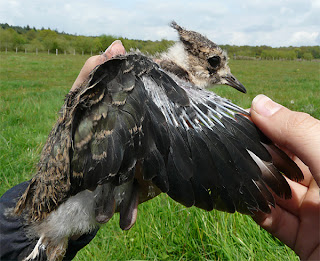I had a few minutes spare this morning before heading off to a family wedding so I opened the 12 metre net in the garden. There was a bit of a stiff breeze and so birds were seeing the net, except that is for one Great Spotted Woodpecker. In typical fashion, as soon as I approached the net it began screaming, and didn't stop until it was safely placed within the bird bag, and then started again when I took it out.....not sure the neighbours would have been to pleased!
 |
| Adult Male Great Spotted Woodpecker |
The bird was a retrap and therefore it gave me the opportunity to test my ageing skills with this species...and so here goes. Firstly it was possible to sex the bird by the presence of red feathers on the nape, this bird was a male. Moult wise, adults undergo a complete post breeding moult which begins in June - mid July and finishing in mid September to late October. Juveniles undergo a partial moult which includes body and primaries, and some (or sometimes all) upper wing coverts. Therefore it is usually possible to see contrast between old and brown unmoulted wing coverts and newer glossy ones in juveniles, whereas adult wing coverts are uniform, although they can retain the odd primary covert.
 |
| Adult Great Spotted Woodpecker Wing |
A close examination of the wing feathers revealed no contrast in the greater or primary coverts, but the tips of the primaries were extremely abraded, which is a typical feature of young birds, since their feathers are not as hard wearing. Although that is not a feature mentioned in Baker (1993), for this species.
 |
| Adult Great Spotted Woodpecker Primary Coverts |
Given the uniform age of the wing feathers it appeared that this bird was an adult, and so to the moment of truth. I looked back through my ringing book and couldn't find this ring number, so got the next oldest book out and there it was, originally ringed on 6th December 2008. This bird was ringed as a juvenile male three and a half years previously, and has not been recaptured since, until today.



